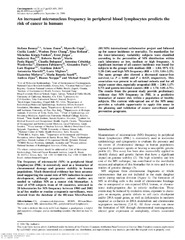Приказ основних података о документу
An increased micronucleus frequency in peripheral blood lymphocytes predicts the risk of cancer in humans
| dc.creator | Bonassi, Stefano | |
| dc.creator | Znaor, Ariana | |
| dc.creator | Ceppi, Marcello | |
| dc.creator | Lando, Cecilia | |
| dc.creator | Chang, Wushou Peter | |
| dc.creator | Holland, Nina | |
| dc.creator | Kirsch-Volders, Micheline | |
| dc.creator | Zeiger, Errol | |
| dc.creator | Ban, Sadayuki | |
| dc.creator | Barale, Roberto | |
| dc.creator | Bigatti, Maria Paola | |
| dc.creator | Bolognesi, Claudia | |
| dc.creator | Cebulska-Wasilewska, Antonina | |
| dc.creator | Fabianova, Eleonora | |
| dc.creator | Fucic, Alexandra | |
| dc.creator | Hagmar, Lars | |
| dc.creator | Joksić, Gordana | |
| dc.creator | Martelli, Antonietta | |
| dc.creator | Migliore, Lucia | |
| dc.creator | Mirkova, Ekaterina | |
| dc.creator | Scarfi, Maria Rosaria | |
| dc.creator | Zijno, Andrea | |
| dc.creator | Norppa, Hannu | |
| dc.creator | Fenech, Michael | |
| dc.date.accessioned | 2018-03-01T20:02:43Z | |
| dc.date.available | 2018-03-01T20:02:43Z | |
| dc.date.issued | 2007 | |
| dc.identifier.issn | 0143-3334 | |
| dc.identifier.uri | https://vinar.vin.bg.ac.rs/handle/123456789/3178 | |
| dc.description.abstract | The frequency of micronuclei (MN) in peripheral blood lymphocytes (PBL) is extensively used as a biomarker of chromosomal damage and genome stability in human populations. Much theoretical evidence has been accumulated supporting the causal role of MN induction in cancer development, although prospective cohort studies are needed to validate MN as a cancer risk biomarker. A total of 6718 subjects from of 10 countries, screened in 20 laboratories for MN frequency between 1980 and 2002 in ad hoc studies or routine cytogenetic surveillance, were selected from the database of the HUman MicroNucleus (HUMN) international collaborative project and followed up for cancer incidence or mortality. To standardize for the inter-laboratory variability subjects were classified according to the percentiles of MN distribution within each laboratory as low, medium or high frequency. A significant increase of all cancers incidence was found for subjects in the groups with medium (RR = 1.84; 95% CI: 1.28-2.66) and high MN frequency (RR = 1.53; 1.04-2.25). The same groups also showed a decreased cancer-free survival, i.e. P = 0.001 and P = 0.025, respectively. This association was present in all national cohorts and for all major cancer sites, especially urogenital (RR = 2.80; 1.17-6.73) and gastro-intestinal cancers (RR = 1.74; 1.01-4.71). The results from the present study provide preliminary evidence that MN frequency in PBL is a predictive biomarker of cancer risk within a population of healthy subjects. The current wide-spread use of the MN assay provides a valuable opportunity to apply this assay in the planning and validation of cancer surveillance and prevention programs. | en |
| dc.rights | openAccess | en |
| dc.source | Carcinogenesis | en |
| dc.title | An increased micronucleus frequency in peripheral blood lymphocytes predicts the risk of cancer in humans | en |
| dc.type | article | en |
| dcterms.abstract | Знаор, Aриана; Цеппи, Марцелло; Ландо, Цецилиа; Цханг, Wусхоу Петер; Холланд, Нина; Кирсцх-Волдерс, Мицхелине; Зеигер, Еррол; Бан, Садаyуки; Барале, Роберто; Бигатти, Мариа Паола; Бологнеси, Цлаудиа; Цебулска-Wасилеwска, Aнтонина; Фабианова, Елеонора; Фуциц, Aлеxандра; Хагмар, Ларс; Миглиоре, Луциа; Миркова, Екатерина; Сцарфи, Мариа Росариа; Зијно, Aндреа; Норппа, Ханну; Фенецх, Мицхаел; Бонасси, Стефано; Мартелли, Aнтониетта; Јоксић Гордана; | |
| dc.citation.volume | 28 | |
| dc.citation.issue | 3 | |
| dc.citation.spage | 625 | |
| dc.citation.epage | 631 | |
| dc.identifier.wos | 000245351100012 | |
| dc.identifier.doi | 10.1093/carcin/bgl177 | |
| dc.citation.rank | M21 | |
| dc.identifier.pmid | 16973674 | |
| dc.identifier.scopus | 2-s2.0-34047154552 | |
| dc.identifier.fulltext | https://vinar.vin.bg.ac.rs//bitstream/id/12397/3174.pdf |

